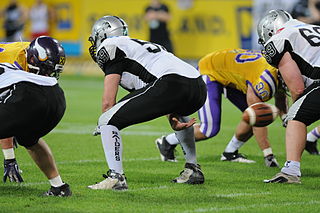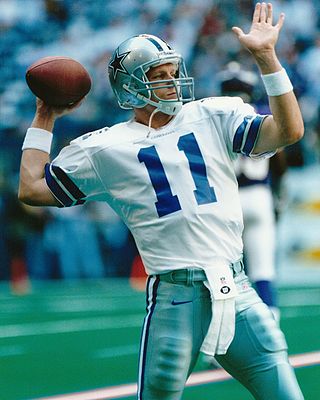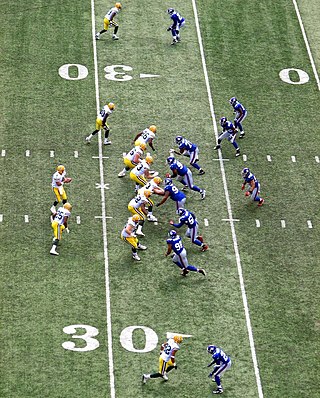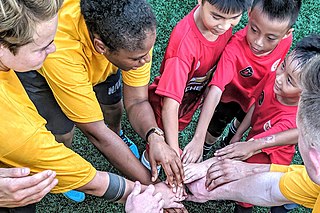Related Research Articles

A snap is the backward passing of the ball in gridiron football at the start of play from scrimmage.

The quarterback, colloquially known as the "signal caller", is a position in gridiron football. Quarterbacks are members of the offensive platoon and mostly line up directly behind the offensive line. In modern American football, the quarterback is usually considered the leader of the offense, and is often responsible for calling the play in the huddle. The quarterback also touches the ball on almost every offensive play, and is almost always the offensive player that throws forward passes. When the QB is tackled behind the line of scrimmage, it is called a sack.

The shotgun formation is a formation used by the offensive team in gridiron football mainly for passing plays, although some teams use it as their base formation. Instead of the quarterback receiving the snap from center at the line of scrimmage, in the shotgun he stands farther back, often five to seven yards off the line. Sometimes the quarterback will have a back on one or both sides before the snap, while other times he will be the lone player in the backfield with everyone spread out as receivers.

In gridiron football, a sack occurs when the quarterback is tackled behind the line of scrimmage before throwing a forward pass, when the quarterback is tackled behind the line of scrimmage in the "pocket" and without clear intent, or when a passer runs out of bounds behind the line of scrimmage due to defensive pressure. This often occurs if the opposing team's defensive line, linebackers or defensive backs are able to apply pass pressure to quickly get past blocking players of the offensive team, or if the quarterback is unable to find a back to hand the ball off to or an available eligible receiver to catch the ball, allowing the defense a longer opportunity to tackle the quarterback.

Samuel David Wyche was an American football quarterback and coach. He was a quarterback and head coach for the Cincinnati Bengals and a quarterbacks coach for the San Francisco 49ers. As head coach, he led the Bengals to Super Bowl XXIII, which they lost to the 49ers 20–16, relinquishing the lead on a last-minute touchdown. He was also known for introducing the use of the no-huddle offense as a standard offense.
Strategy forms a major part of American football.

Gameplay in American football consists of a series of downs, individual plays of short duration, outside of which the ball is dead or not in play. These can be plays from scrimmage – passes, runs, punts or field goal attempts – or free kicks such as kickoffs and fair catch kicks. Substitutions can be made between downs, which allows for a great deal of specialization as coaches choose the players best suited for each particular situation. During a play, each team should have no more than 11 players on the field, and each of them has specific tasks assigned for that specific play.
In gridiron football, clock management is an aspect of game strategy that focuses on the game clock and/or play clock to achieve a desired result, typically near the end of a match. Depending on the game situation, clock management may entail playing in a manner that either slows or quickens the time elapsed from the game clock, to either extend the match or hasten its end. When the desired outcome is to end the match quicker, it is analogous to "running out the clock" seen in many sports. Clock management strategies are a significant part of American football, where an elaborate set of rules dictates when the game clock stops between downs, and when it continues to run.
A formation in American football refers to the position players line up in before the start of a down. There are both offensive and defensive formations and there are many formations in both categories. Sometimes, formations are referred to as packages.

In American football and Canadian football, a quarterback kneel, also called taking a knee, genuflect offense, kneel-down offense, or victory formation, occurs when the quarterback touches a knee to the ground immediately after receiving the snap, thus downing himself and ending the play. It is primarily used to run the clock down, either at the end of the first half or the game itself, to preserve a lead. Although it generally results in a loss of some yardage and uses up a down, it minimizes the risk of a fumble, which would give the other team a chance at recovering the ball.

A halfback (HB) is an offensive position in American football, whose duties involve lining up in the offensive backfield and carrying the ball on most rushing plays, i.e. a running back. When the principal ball carrier lines up deep in the backfield, and especially when that player is placed behind another player (usually a blocking back), as in the I formation, that player is instead referred to as a tailback (TB).

In sport, a huddle is the action of a team gathering together, usually in a tight circle, to strategize, motivate or celebrate. It is a popular strategy for keeping opponents insulated from sensitive information, and acts as a form of insulation when the level of noise in the venue is such that normal on-field communication is difficult. Commonly the leader of the huddle is the team captain and it is the captain who will try to inspire other team members to achieve success. Similarly after an event a huddle may take place to congratulate one another for the team's success, or to commiserate a defeat. The term "huddle" can be used as a verb as in "huddling up."

The spread offense is an offensive scheme in gridiron football that typically places the quarterback in the shotgun formation, and "spreads" the defense horizontally using three-, four-, and even five-receiver sets. Used at every level of the game including professional, college, and high school programs across the US and Canada, spread offenses often employ a no-huddle approach. Some implementations of the spread also feature wide splits between the offensive linemen.

Arthur Gustavo Malzahn III is an American football coach. He is currently the head coach at the University of Central Florida (UCF). He was the head football coach at Auburn University from 2013 to 2020. He helped lead the 2010 Auburn Tigers to a National Championship. As head coach at Auburn, he led the team to a SEC Championship win and an appearance in the 2014 National Championship. Malzahn has coached Heisman winner Cam Newton and two Heisman finalists: Tre Mason and Nick Marshall. During Malzahn's tenure at Auburn, he qualified as the second-longest tenured head coach at one school in the SEC, behind Nick Saban. Out of active head coaches, Malzahn also holds the best record against coach Saban.
The 1990 Buffalo Bills season was the 31st for the franchise and the 21st in the National Football League (NFL). The team finished the year with a record of 13 wins and 3 losses, and first in the American Football Conference (AFC) East division. They were 8–0 at home for the second time in their franchise history. On the road, the Bills were 5–3. Buffalo qualified for their first Super Bowl appearance, but lost 20–19 to the New York Giants after an infamous missed field goal by Scott Norwood in the game's closing seconds.
The A-11 offense is an offensive scheme that has been used in some levels of amateur American football. In this offense, a loophole in the rules governing kicking formations is used to disguise which offensive players would be eligible to receive a pass for any given play. It was designed by Kurt Bryan and Steve Humphries of Piedmont High School in California.
The following terms are used in American football, both conventional and indoor. Some of these terms are also in use in Canadian football; for a list of terms unique to that code, see Glossary of Canadian football.
Wildcat formation describes a formation for the offense in football in which the ball is snapped not to the quarterback but directly to a player of another position lined up at the quarterback position. The Wildcat features an unbalanced offensive line and looks to the defense like a sweep behind zone blocking. A player moves across the formation prior to the snap. However, once this player crosses the position of the running back who will receive the snap, the play develops unlike the sweep.
A play calling system in American football is the specific language and methods used to call offensive plays.
References
- ↑ Malzahn, Gus. "The Hurry-Up, No-Huddle: An Offensive Philosophy", p. 11.
- ↑ Glover, J. "No Huddle? More Chances" American Football Monthly, Dec 2005 issue. Available online at AFM Archived 2008-12-04 at the Wayback Machine
- ↑ Gwynne, S.C. (2016-09-20). "Epilogue: The Game Changes". The Perfect Pass: American Genius and the Invention of Football. Scribner. ISBN 978-1501116193.
- 1 2 "Mossman: Hurry-Up Not New at OU – University of Oklahoma".
- ↑ John Heisman: Auburn ‘the first to show what could be done’ with the hurry-up offense: The War Eagle Reader
- 1 2 "Wyche likes Bengals' retro no-huddle", Associated Press. Available online at sportingnews.com
- ↑ Eskenazi, G. "No-Huddle Rule Wasn't An Easy Snap for Esiason". New York Times, January 11, 1989. Available online at nytimes.com
- ↑ Warren, Matt (December 2, 2010). "December 2, 1990 – Bills Unveil No-Huddle Offense" . Retrieved October 30, 2018.
- ↑ "Denver Broncos' Peyton Manning Revolutionized NFL Offense". CBS. Retrieved 2 August 2019.
- ↑ "2014 Pace Stats". Football Outsiders . Archived from the original on 2014-12-17. Retrieved 2014-12-02.
- 1 2 Theismann, J, and Tarcy, B "The Complete Idiot's Guide to Football", p. 132 (2nd ed). Available online at Google book search